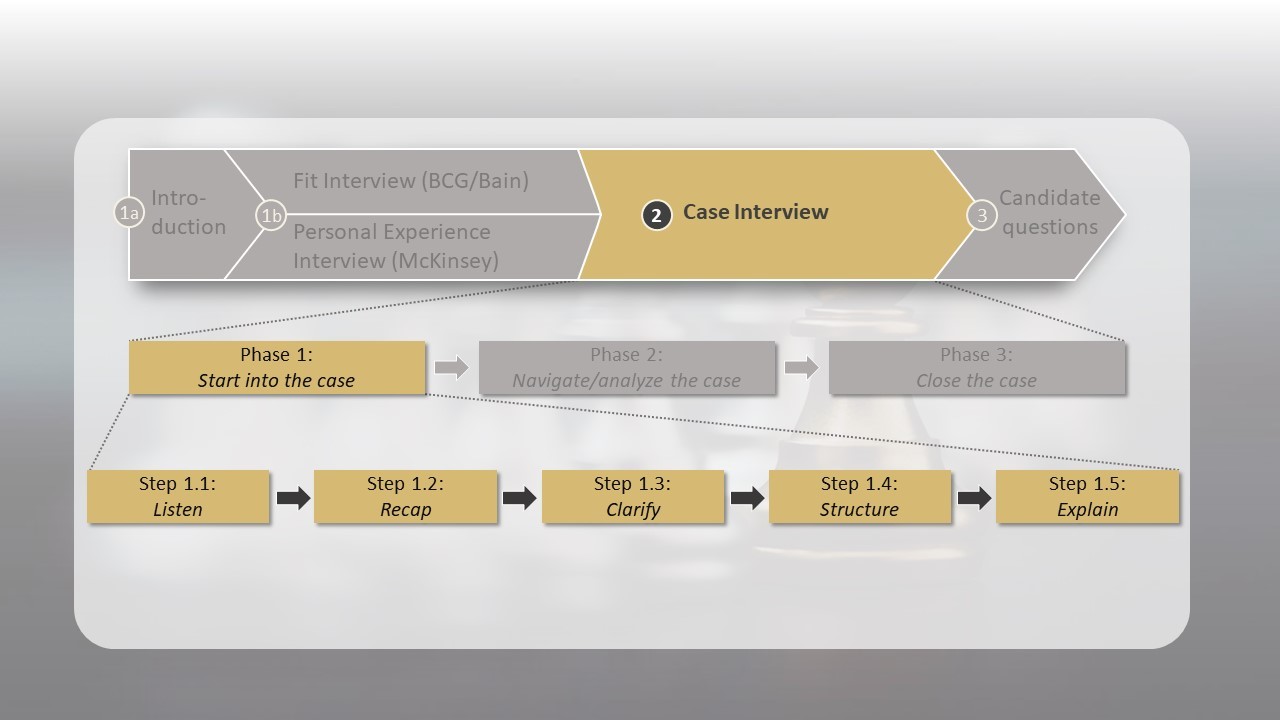What should be the approach of solving a case study interview whether one should start with Clarifying questions about the case, tell the framework/approach to the interview and then ask for data to solve case or rather explain one component of the framework, ask for data and then move to the other component ?
Need advice from the experts !
Case Study Interview


Hi there,
Q: One should start with Clarifying questions about the case, tell the framework/approach to the interview and then ask for data to solve case or rather explain one component of the framework, ask for data and then move to the other component?
The first option (present the whole approach that answers the question and then ask for data) is much better. The main reasons are:
- With the second approach (present one component only and ask data for that without presenting the rest) the interviewer won’t really know how you want to structure until you move forward.
- If the case is interviewer-led you might never have the option to move there, as the interviewer might ask as following question something specific to the part of the structure you have not presented yet (eg a math question).
Please note that your initial approach/structure should answer the specific question of the interviewer. If they say that we have a decline in profits and they ask which elements could affect revenues, you should present a structure on the elements affecting revenues, not on what is creating the profits problem.
Best,
Francesco

Hi there,
First of all, every case/company is different. So, the #1 rule is to be flexible.
They might want to skip the framework. They might jump straight in with brainstorming. They might not want a final recommendation. Be flexible.
In general:
- Hear the prompt
- Repeat the prompt back in your own words
- Ask clarying questions
- Ask for a moment for framework
- Take time then tell them your framework
- Drive the case forward if it's a candidate-led case (ask for data, yes)
- At end of case give recommendation

Hi!
Before I can do effective coaching sessions with them, all my mentees need to first establish a solid foundational understanding of the dynamics and anatomy of case interviews.
Starting into a case is just the first out of three principal “phases” during a case discussion. And it contains five steps, as outlined on the exhibit. Please check out this exhibit and read the below rough description of the five steps. This should already help I hope.

STEP 1: Listen
Listen carefully to the initial outline of the question / the problem statement shared by the interviewer
- Take notes
- Mark unclear/missed information
- Identify core question!
STEP 1.2: Recap
Briefly repeat the problem statement (“paraphrase”)
- Double check your understanding
- Prevent misinterpretations / allows interviewer to clarify points misunderstood
Step 1.3: Clarify
Ask clarifying questions
- Objectives:
- Understanding context/situation
- Understanding scope of the question(s)
- Understanding underlying objective(s) of the client
- NOT meant to start the analysis already! → Do NOT randomly ask for specific data!
Step 1.4: Structure
Take time and draft your analytical approach (“your structure”)
- Always announce towards the interviewer that you want to take a moment to outline your approach!
- Then draft your structure with pen and paper
- Properly structuring case questions is THE central foundation for delivering consistent excellent performances in case solving!
- Core skill which needs to be learned! You don't learn this in university or business school!
Step 1.5: Explain
Walk the interviewer through your structure
- Once done with crafting your logic, you need to explain this logic to the interviewer
- Top-down communication! à start from core question à outline required insights to answer this core question
- Explain the RATIONALE behind your approach! à always justify WHY you’re doing what you’re doing!
- DO NOT just list areas/buckets!
- Prioritize required analyses!
- Align with interviewer on your approach; adapt your structure, if the interviewer gives you specific guidance!
Cheers, Sidi
_______________________
Dr. Sidi Koné
(Former Senior Engagement Manager and Interviewer at McKinsey | Former Senior Consultant and Interviewer at BCG)

The first thing is to make sure you know what is the problem you are trying to solve. That is why you ask clarifying questions, so you know the context, contraints and exact goal.
Only then you structure an approach.
And only after structuring an approach you would start to explore the case.

Hi there,
The order you suggested makes sense high level.
At the end of the day, however, you should think of the case study portion of the interview as a business conversation. You're trying to think with the interviewer (aka the client) through a particular situation. That means that you shouldn't stick to any strict rules of how this conversation should go. Just make sure that it's insightful, structured and well-communicated.
Best,
Cristian

Hello,
Listen to the case prompt. Then, ask any clarifying questions you have to make sure you are clear on the set-up and the task at hand. Next, you would usually ask to take some time and set up your framework. Present your framework to the interviewer, and dive into the case from there.
I recommend taking a look at some intro to case interviews materials on PrepLounge and/or videos of case interviews to understand how case interviews are usually structured.














